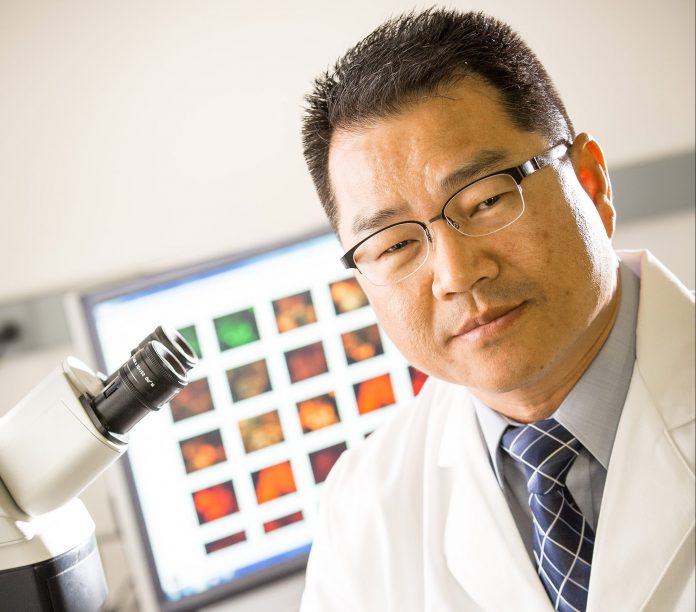Because it is often diagnosed in its early stages, bladder cancer is highly treatable upon discovery. However, bladder cancer has a high rate of recurrence, typically because tumors too small to be detected continue growing after initial treatment.
A researcher with the University of Oklahoma College of Pharmacy is studying a new way to find and eradicate bladder cancer cells that often evade detection. Youngjae You, Ph.D., recently received an almost $600,000 federal grant to continue his work, which focuses on an approach called photodynamic therapy.
Bladder cancer is the fourth most common cancer in men. When it is found early, physicians, including those at the Stephenson Cancer Center, often treat it through a procedure called transurethral resection of bladder tumor. After a fluorescent agent is injected into the bladder to illuminate the cancer cells, a thin, lighted tube called a cystoscope allows physicians to insert an instrument to burn away cancer cells using an electric current. Based on a biopsy, physicians may recommend follow-up treatment, such as chemotherapy. Bladder cancer is among the most costly cancers to treat because of high recurrence, intensive surveillance and expensive treatment.
“The target of our approach is the small, flat cancer cells that can go undetected,” You said. “We want to find and kill those tumors early and reduce the patient’s risk of recurrence.”
You’s hypothesis is that the same fluorescent agent that illuminates cancer cells can be harnessed to kill small tumors inside the bladder. This small fluorescent molecule is instilled in the bladder, where cancer cells absorb more than normal cells. The fluorescence not only makes the cancer cells visible, but it generates a form of oxygen – called singlet oxygen – that can destroy the tumors. However, the singlet oxygen requires an additional boost of power to sufficiently kill cancer cells. You’s research involves adding a non-toxic version of an existing anti-cancer drug to the research model. The singlet oxygen then converts the non-toxic drug into a toxic, cancer-destroying version of the drug.
“Our strategy is to use the specificity of the fluorescent detection, combined with photodynamic therapy, to destroy the cancer cells while minimizing side effects and damage to nearby healthy cells,” he said.
You has received funding for his bladder cancer research for several years from the American Cancer Society. His latest grant will allow him to further validate his findings. He works closely with other faculty in the College of Pharmacy (Sukyung Woo, Ph.D.) and the College of Medicine (Robert Hurst, Ph.D.), as well as a clinical colleague (Sanjay Patel, M.D.) who treats patients with bladder cancer. The grant is from the Department of Defense, Department of the Army, which is interested in helping military members and veterans diagnosed with bladder cancer. Veterans are at higher risk of bladder cancer than the general population because they have a higher rate of smoking, which is the leading risk for the disease. Veterans also face a higher risk of being exposed to chemicals that can cause bladder cancer.
You’s research is important because it has the potential to move from the “bench to the bedside” to help patients in Oklahoma and beyond, said James Tomasek, Ph.D., vice president for research at the OU Health Sciences Center.
“Dr. You’s commitment to finding a better, more precise method of treating bladder cancer is at the heart of what our researchers do at the OU Health Sciences Center,” Tomasek said. “He understands the needs of physicians and their patients and is using his skills in basic science to discover new answers.”












